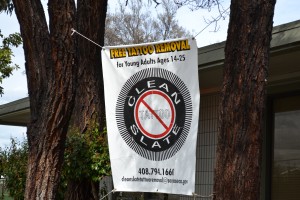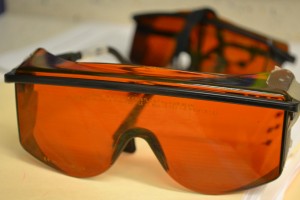
“We were looking for love and we didn’t find it at home. We found it in gangs.”
Azucena Campos said she realizes the statement may sound strange, given the common affiliation of gangs with violence and general criminality. But when her parents divorced six months before her 13th birthday and her mother began a new relationship, Campos and her older sister felt abandoned.
So Campos joined a gang, hoping to find the sense of belonging and camaraderie that she was no longer finding at home.
“They were my homegirls; they were going through similar things,” Campos says, her voice wavering slightly. “I just felt like I wanted someone to tell me ‘I’m here for you,’ and I did find that through the gang.”
She also found herself in trouble. At 13 she went to juvenile hall for the first time for fighting a rival female gang member at school and ran away from home with her boyfriend of that time. He knew how to give people tattoos, and convinced her to get a tattoo of his name on her chest.
Five years passed. Campos was thrown in juvenile hall three more times for fighting and theft. While at the Muriel Wright Residential Center for Girls, a detention and rehabilitation center in San Jose, a guest speaker offered her the chance to obtain what she had lacked since the start of her adolescence: a clean slate, physically and metaphorically.
“It was a revolving cycle of juvenile hall and probation, and I never got off,” Campos says. “Somehow I found a way out.”
Campos enrolled in San Jose’s Clean Slate Tattoo Removal Program, a city-funded effort run by the Mayor’s Gang Prevention Task Force that comes at no cost to its participants. Launched in 1994 as one of the first pilot programs of its kind, it offers San Jose youth with criminal records and/or former gang affiliation the chance to remove the tattoos that are prohibiting them from moving forward with their lives. Before beginning the removal process, participants must complete 10 weeks of life skill classes and perform 30 hours of community service. These classes cover an array of topics, from relationship advice and communication to how to apply for a job. Participants are also required to have a job or be enrolled in school.
Since San Jose’s tattoo removal program began, several others have sprouted up, including in Santa Rosa, Los Angeles and Fresno.
Clean Slate enrolls 100-150 San Jose residents each year and boasts a success rate near 90 percent, meaning that participants complete the program and get their tattoos removed. But while this intervention program continues to rehabilitate formerly troubled youth, it operates in a city that last year saw its highest homicide rate in two decades. Out of the 46 murders in San Jose last year, 18 were gang-motivated. The majority of victims and assailants in all gang-related crime over the last five years have been between the ages of 17 to 24.
Though gang-related assaults and non-violent incidents have decreased over the last few years, Division Manager for Neighborhood Engagement Mario Maciel recognizes that San Jose has much room to improve when it comes to preventing youth from joining gangs and intervening once they do, and he believes Clean Slate is central to this effort. He accounts for the rise in gang-related homicides by saying that today’s youth “are just quicker to the steal, whether it be with a knife or a gun, to mitigate their conflicts.”
“Although there may be less incidents of violence occurring out there, those that remain are more lethal and volatile,” Maciel says. “Unfortunately here in San Jose we do not have the silver bullet.”
“Many of these young people in this lifestyle are missing hope, and anyone without hope is very dangerous.”

When Clean Slate was launched nearly 20 years ago, its popularity was immediate. Program organizers appeared on Good Morning America, and waitlists were filled with twice as many people as there were spots.
Nowadays, the waitlists are shorter due in part to budget cuts that have eliminated some of the organizations that used to refer youth to Clean Slate. Clean Slate organizers shy away from referrals, says Maciel, because they are not proof enough that the individual is motivated to make a change.
“It’s imperative that we do intensive screening,” Maciel says, sitting at a conference table tucked away in the Hank Lopez Community Center, where life skills classes for Clean Slate participants are held. “If in the assessment process you are not able to articulate that this is a change within you, you will not be allowed in the program.”
Clean Slate youth outreach worker Sam Garcia says many people come to Clean Slate after finding it difficult to obtain employment or avoid the stares of classmates and passerby.
“We’re getting a lot of clients that are finding themselves having issues getting jobs,” Garcia says. “That as well as going to school and not having to be stereotyped.”
Garcia added that participants are often nervous when starting the program. He recalled a story from one client who is 25 years old and has nine children.
“His kids have told him ‘Wow, you’re going to look different’” without tattoos. “He took it wrong at first because he was so used to having his tattoos all the time, but he also knows they realize it’s a good thing,” Garcia related.
Lizandra, a 20-year-old Clean Slate participant who preferred not to give her last name, has four tattoos on her neck, arm, behind her ear and on her shoulder. Although she was never affiliated with a gang, she feels that some people assumed she was when they saw her tattoos. She recounts a time when a police officer stopped her when she was walking down the street and asked about her tattoos.
“He stopped me just because of my tattoos,” she says, tapping her fingertips to her neck, which is currently covered by her shoulder-length black hair. “He looked at me and said, ‘Is that a spider?’ and I said yeah, and just because of that he asked how to spell my name just to see my records.”
Campos also feels that she has been treated differently because of her tattoo. Though it is placed on her chest, the script is visible if she wears a tank top or v-neck shirt.
“When I met people they just judged me,” she says. “It wasn’t a gang-related tattoo but I feel like they thought less of me, and I didn’t like that.”
That and her mounting criminal record motivated Campos to call Clean Slate. After hearing the Clean Slate representative speak, Campos called her probation officer to express her interest in the program. After completing the life skills course and 30 hours of community service, she began getting her tattoo removed.

Although the metaphor of making one’s body a clean slate by purging the marks of a past life may sound poetic, one cannot romanticize the physical process of getting tattoos removed: it hurts.
“How bad is the pain on a scale of 1-10?” asks Dr. Jack Ackerman after Campos’ removal session.
“A six,” she responds.
Campos says her life skills class prepared her for the pain by comparing the laser used to remove the tattoo to a rubber band being snapped against one’s wrist.
“It’s more painful getting it removed than it was getting the tattoo,” she says from the fourth floor waiting room of Valley Medical Specialty Center, awaiting her twelfth treatment session. “It just feels like hot grease, if when you’re cooking it falls on you.”
Clean Slate clients go to Valley Medical Specialty Center once every six to eight weeks to ebb away at their tattoos. Though removal sessions take only 5 to 15 minutes depending on the number and size of the tattoos, clients may wait up to three hours because they are seen on a first-come, first-serve basis on the day their session is scheduled.
The length of time for tattoo removal depends on numerous factors besides the quantity of tattoos, Dr. Ackerman said. He cited the amount, its color and the individual’s immune system as the most important factors. Because the laser in essence burns the skin and causes it to swell, a patient must wait until the skin has healed before returning for their next removal session.
“The laser penetrates several millimeters underneath the skin and into the bone, because tattoo pigment goes into the bone and tendons,” Ackerman says, demonstrating the laser on a piece of paper. The laser fires off a round of popping noises, bouncing circles of light off the sheet.
Ackerman says the tattoos he sees most commonly from Clean Slate patients are not professionally done and often exhibit a name or place. The most obvious gang-related markings are the numbers 13 and 14, indicated with one dot on one hand and three or four on another or with Roman numerals. The number 13 stands for the 13th letter of the alphabet, M, an abbreviation for “Mexican Mafia,” the nickname of the Sureño gang. The number 14 signifies the 14th letter N, for Norteños.
It may take a patient as few as eight or nine sessions or as many as 25 to get their tattoos removed. No matter how long the process, Garcia says patients are grateful and relieved when they realize treatment is nearing its end.
“It’s an excitement that they know they’ve gone so far to have accomplished it and see that it’s gone,” he says. “They’re in awe but at the same time they’re ready to move on with the rest of their life.”

As Clean Slate continues to leave its mark by removing marks from dozens of San Jose young adults each year, the Gang Prevention Task Force is also looking at additional ways to improve youth outreach.
An already-existing partnership with Valley Medical Center through Clean Slate helped spawn a new program in which a Gang Prevention Task Force representative pays a bedside visit to a young adult who has recently been shot or stabbed.
“We have been missing the mark as far as meeting those youth who are victims of gang and youth violence to come bedside and engage with them,” Maciel says. “We’re coming bedside to let them know who we are, that we care and that they are not broken.”
Maciel adds that he believes Clean Slate will continue to play an essential part in gang intervention, calling the program “one constant that has endured several mayors.”
Program participants like Campos credit Clean Slate with helping them turn their lives around. Campos is employed and was recently accepted to San Francisco State’s nursing program and is excited for the day her tattoo is no longer visible on her chest so she can “be comfortable” in her “own skin” and not have to worry about what she wears.
“I wasn’t excited for the future, but now I am. It really is a clean slate to start over, and sometimes people need that.”
For more information on Clean Slate, email cleanslatetattooremoval@sanjoseca.gov
